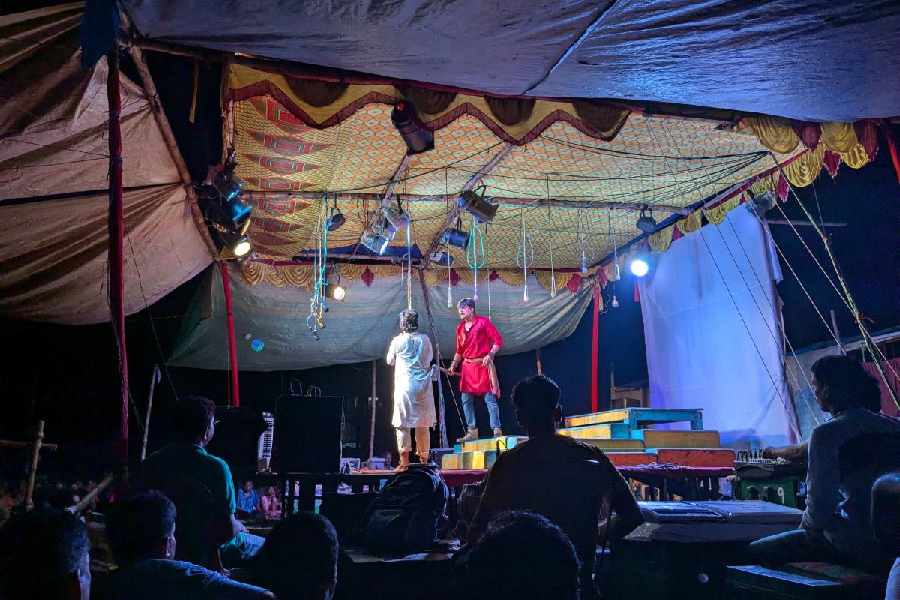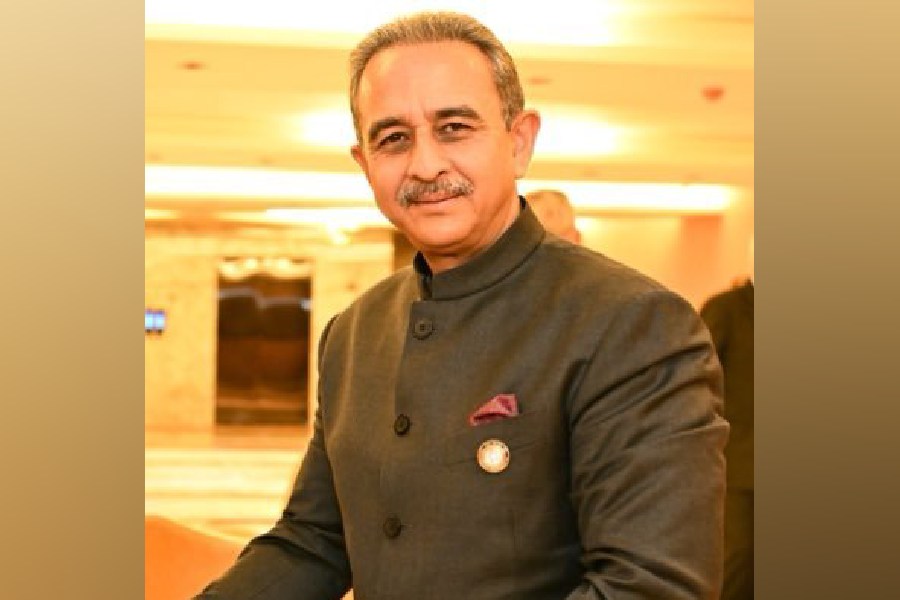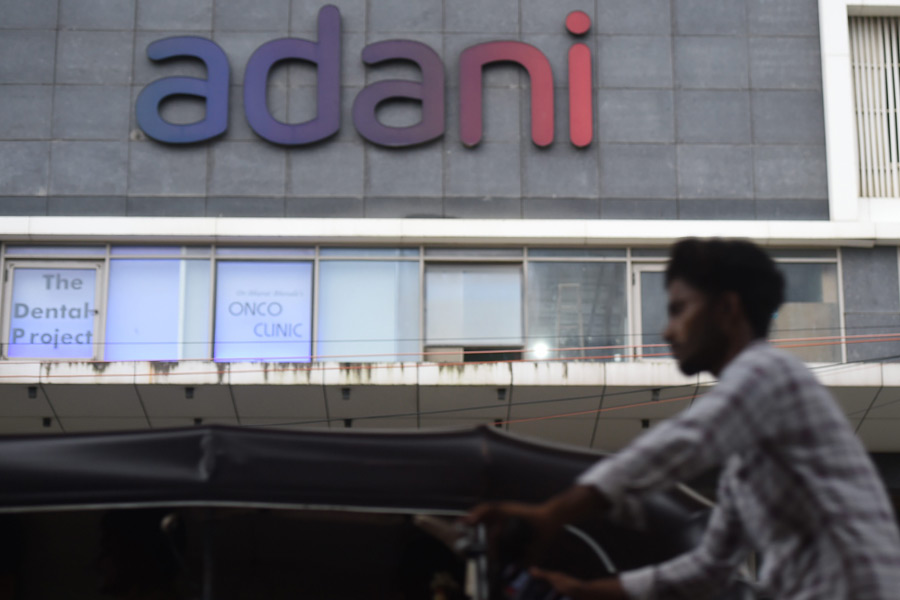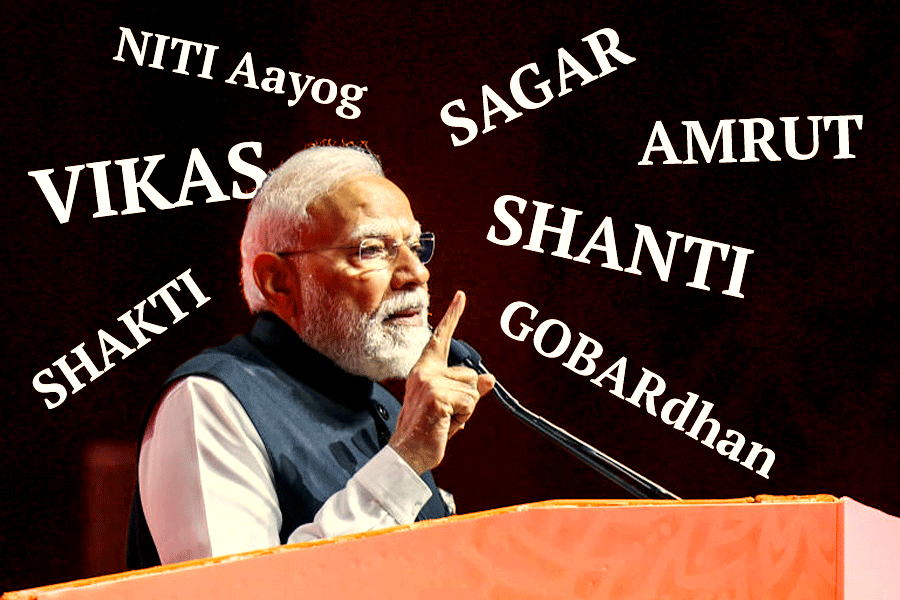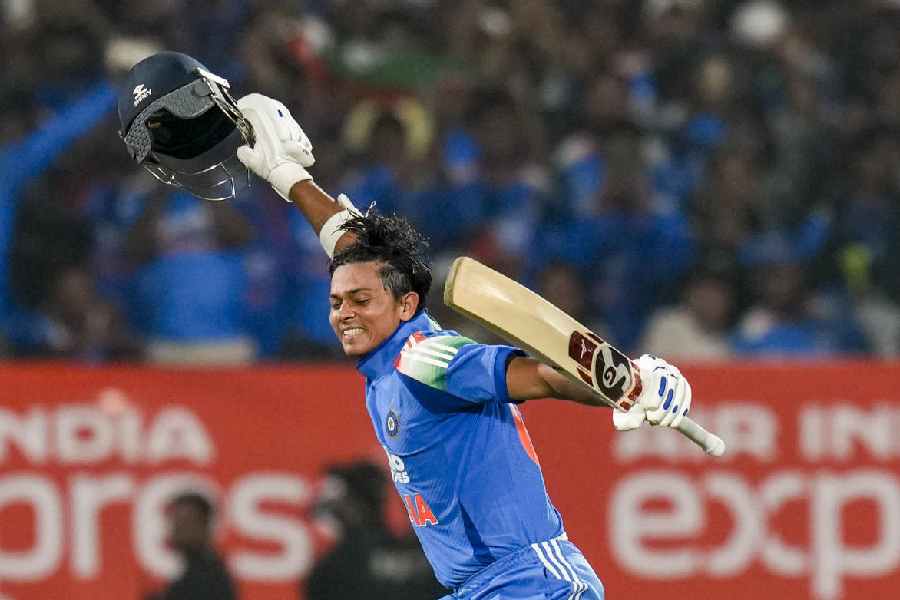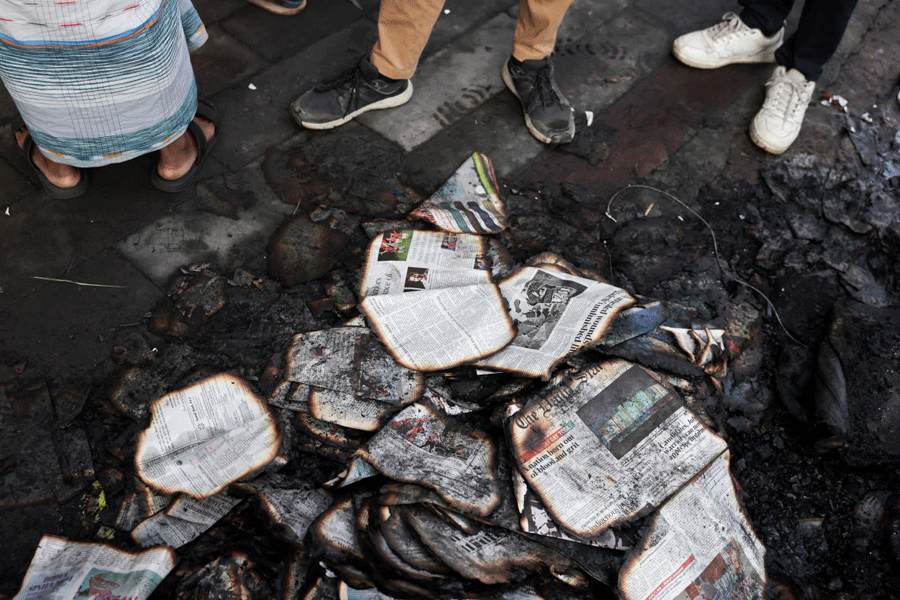Flashes of light, deafening music, a flourish of drums and then, silence. Next, half a dozen men and women enter with candles in hand. They punch the air even as the sound boxes begin to play the Arijit Singh number “Aar kobe, aar kobe”.
It is the opening scene of the jatra pala Ami Chhoddobeshi Nayak. I am at Dhospara village square in South 24-Parganas’ Sagar Island. Jatra is a genre of theatre specific to Bengal. Pala is the Bengali word for a performance.
The protagonist of Ami Chhoddobeshi Nayak is Proloy, a doctor who takes up the cudgels against a fake medicine racket run by a nexus of politicians and criminals, till he is brutally murdered.
Dhospara might be 110 kilometres away from Calcutta, but there is a 5,000 plus audience that evening. Most of them are young people, between 18 and 30 years of age. Playwright Manjil Banerjee’s fiery dialogues about corruption and dirty money seem to be a great hit with them. They hoot, clap and whistle from time to time.
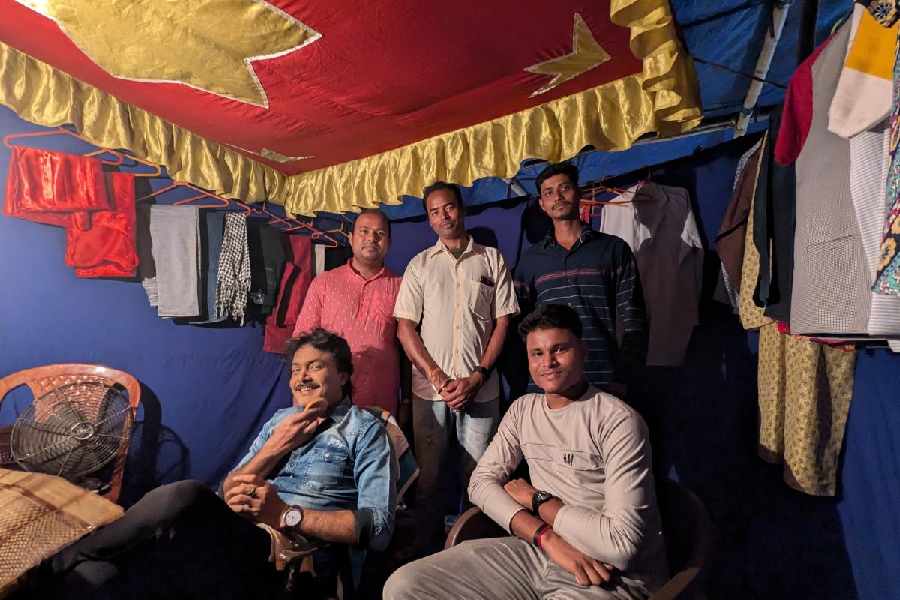
Pradip Kumar, who plays a doctor in Ami Chhoddobeshi Nayak, a jatra pala at Dhospara, Sagar Island.
Some even share clips of the play on social media. There are various online platforms such as Jatra Sagar, Jatra Amar Pran and Gitimoy, which stream video clips from performances, trailers of palas and short interviews of stars. Dibyendu Das, 26, who runs Jatra Sagar, tells me, “I travel across Bengal to watch and promote jatra palas.”
Dibyendu says he gets millions of views for each clip, which explains the obvious respect he commands with actors and producers. “He’s one of our key media partners,” says Raju Maity, co-owner of Maity Productions, one of the jatra production companies of Chitpur. This particular play, however, has been produced by Deblok Opera, which is also based in Chitpur.
The art form of the jatra dates back to the 16th century. Saint and social reformer Sri Chaitanya Mahaprabhu used a version of it to spread his message of equality. He would enact mythological tales from the life of Krishna in village squares, with the express intent of shaking up the rigid Hindu caste system.
Today, most jatra companies or “operas” of Bengal are either based in Chitpur in central Calcutta or Nandakumar in East Midnapore. No matter what the seeming distance from the days of Sri Chaitanya, their chief proponents continue to use this medium to make bold social and political statements, and to register citizens’ protests.
Ami Chhoddobeshi Nayak is a nod to the R.G. Kar case from August 2024.
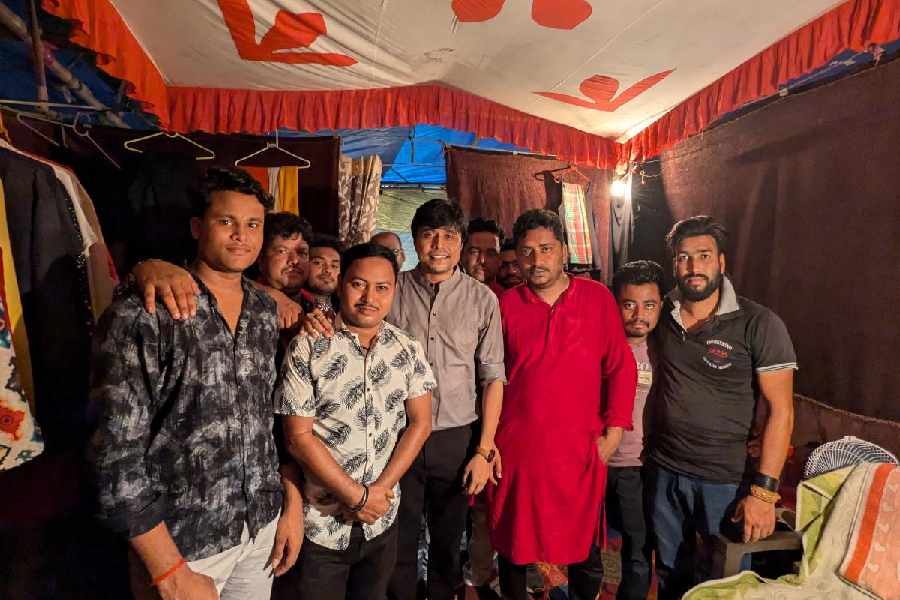
Anik Banerjee (fourth from right) with his following.
Manjil, who according to many is the most successful playwright of these times, says, “In Ami Chhoddobeshi Nayak my focus was scams in the healthcare sector.” Some of his other plays on similar themes are Mati Mayer Khanti Chhele and Bagdiparar Baghini. Manjil also wrote the pala Gnayer Mati, Mayer Khoma based on the Singur land movement.
The Bengali word jatra also means journey. The jatra companies routinely travel across Bengal and pockets of eastern India with their shows. I decided to hitch a ride with two leading jatra stars Pradip Kumar and Arijita Das Roy whose stage name is Mohini.
From Tollygunge we drove to Kachuberia ferry ghat by the Muri Ganga river. We crossed the estuarine river and landed at LCT Ghat in Sagar Island,
and travelled another 30 kilometres in another car.
On the way to Dhospara, Pradip spoke about becoming a jatra actor “accidentally”. The 42-year-old said, “I hated jatras in my youth because the actors shouted and laughed melodramatically in mostly mythological plays.” Pradip is from East Midnapore, initially trained to be a teacher. Somewhere along the way, a friend asked for his help to write a script for a local pala and he was hooked.
Mohini, 32, started her career in the movies and dabbled in TV serials as well. The duo has starred in hit palas such as Mr Amanush, No. 1 Criminal and Ami Kolir Karna. Mr Amanush was about a police officer who takes the law into his own hands, secretly kills criminals who go unpunished; No.1 Criminal is about the political system that turns an underprivileged youth into a criminal; and Ami Kolir Karna is about a soldier who finds himself framed.
Before the trip, I had met Anol Chakraborty, 60 — another big name in this circuit — at Phanibhushan Jatra Mancha in Bagbazar, on the sidelines of a jatra festival organised by the state government. He told me only those scripts that reflect the realities of rural life strike a chord with audiences today.
His 2007 pala Ami Haridas Paler Bou was based on Singur and Nandigram. “The then chief minister Buddhadeb Bhattacharjee came to see it. He congratulated me for portraying the land acquisition issue from the villagers’ viewpoint,” says Anol.
The veteran actor/playwright criticised the Maoist insurrection in his 2008 play Ami Miss Calcutta. “Political realities need to be contextualised in the script along with a strong social message. These are the key ingredients of a successful pala,” he stresses. Some of his more recent palas are on a range of themes from the portrayal of a psychopath lover to nuances of village politics.
Arpita Ghatak, who has done research on the jatra culture of Bengal, says, “In the 1960s-70s, jatra became a powerful instrument to mobilise political participation among the rural Bengali people.” Indeed, before “maa mati manush” became the watchword of the Trinamool, it was recognised as the name of a super-hit pala from the mid-1970s. It was about the victory of peasants against landlords and the rise of the Left in Bengal.
“Even the 1980s were good times for jatra. Many of my father’s palas ran for 200 nights and more,” adds Meghdut Ganguly, son of Bhairab Ganguly and current proprietor of Bhairab Opera. Some of their well-known productions from that time are Rakte Ranga Dhaan, Achal Paisa and Ghum Nei, based on peasants’ and labourers’ struggles.
Most opera owners such as Kanak Bhattacharya seemed to pin the downfall of jatra to the 1990s and blamed the “infiltration of actors from the Bengali and Hindi film industry” for it. The dying art form was resuscitated at the turn of the millennium by — surprise, surprise, the West Bengal government.
The current trend of jatra being a rage with the state’s suburban youth can be traced to 2021, just after the pandemic. Says playwright Anik Banerjee, “Village youth find screens, small or big, restrictive. They want to catch live action under the
open sky”. And not just any action. As Pradip puts it, “They cannot quite connect with web series and TV serials. Jatra is a reflection of their immediate context, their world.”
Just because jatra enjoys state patronage it doesn’t mean the palas are
politically neutered. Jatra caters to Bengal’s villages where life is heavily politicised, but naturally, they speak to a variety of socio-political issues. And though no one is willing to come on record and say it, it is also true that jatra companies and playwrights ensure that they do all of that without upsetting the powers that be.
Many of the palas have to do with women’s issues. Not saas-bahu themes though. Nilkamal Chattopadhyaya’s pala titled Dosh Maathar Durjodhan is about a college student being persecuted by a student union leader.
The pala with the record number of shows — 187 nights — from last winter is Anik’s Rajbeshe Bhikhari Samrat produced by Prabhas Opera of Maity Productions.
Anik invites me to see the pala at Banagram, a remote village in Birbhum. I go and see for myself the excitement around the pala centred on the Mahabharata’s Bhisma, but set in modern times.
Like Dhospara, here too, young people make up most of the audience. The 20-something Zaheed has driven 190 kilometres, all the way from Sonamukhi in Bankura, to catch the show. “I am seeing it for the 18th time,” he tells me. After the play ends, fans rush to the green room to grab a selfie with Anik.
In the meantime, he’s announced the name of his next season’s play — Ami Bhindeshi Bohurupi.

